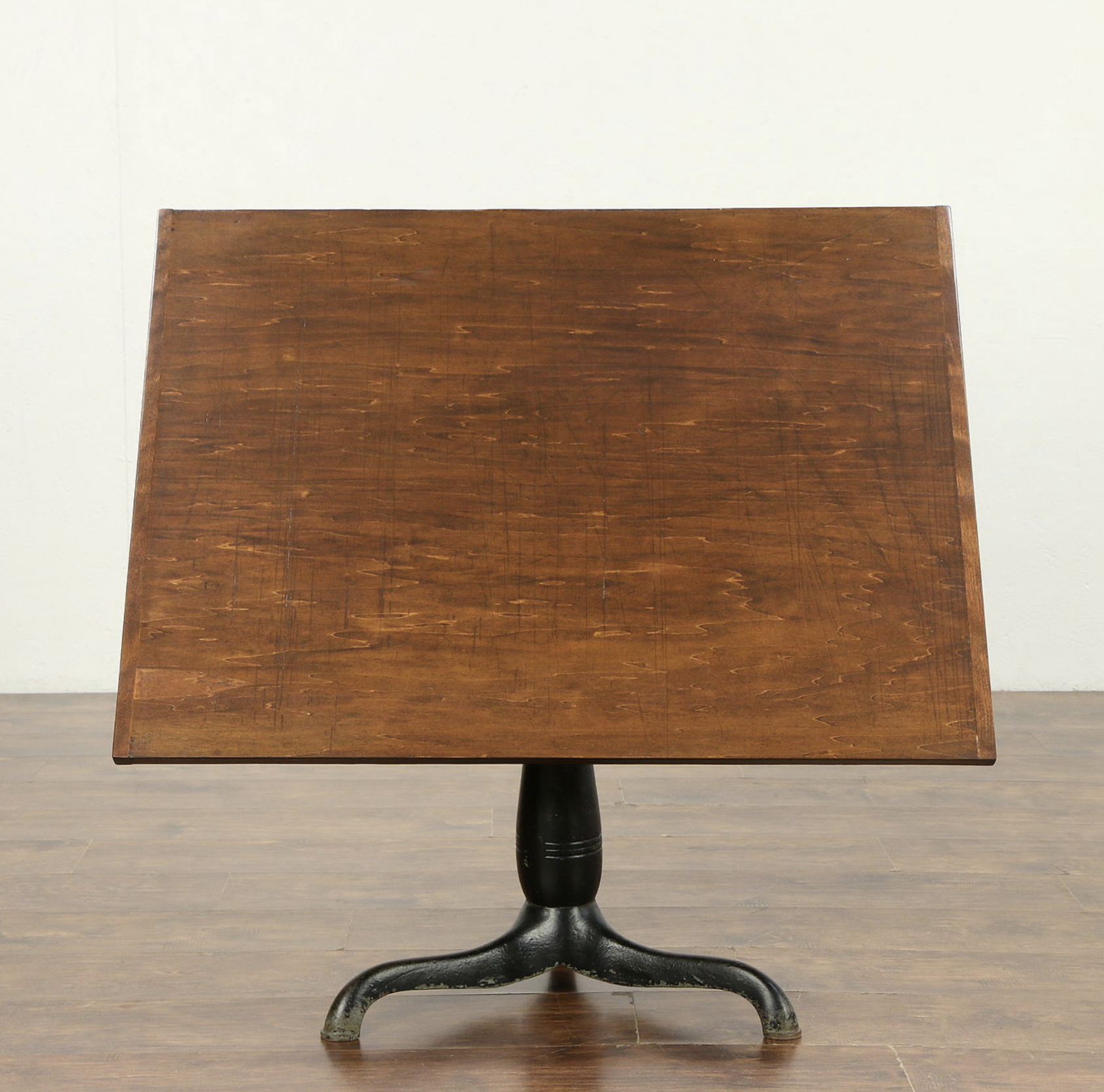

Title: 20th century Antique Industrial Architectural Drafting Artist Table
Shipping: $29.00
Artist: N/A
Period: 20th Century
History: Art
Origin: North America > United States
Condition: Excellent
Item Date: N/A
Item ID: 660
This rare, turn-of-the-century industrial engineering drafting table or artist's desk features a fully adjustable design, making it ideal as a drawing table. These types of desks are highly sought after in the interior decorating world, known for their versatility and aesthetic appeal. They look stunning when paired with a glass or marble top, creating a unique and elegant look. The wooden top includes a swivel mechanism, while the base is industrial, heavy, and exceptionally sturdy, ensuring stability during use. These desks are in high demand and add a cool, stylish touch to any interior. The cast iron base retains its original worn black paint, and the iron mounts and bolts allow for height and tilt adjustments. The desktop measures 41" by 38," and the height can be adjusted from 33" to 45" when the top is positioned flat. Please refer to the photos for more details. This beautiful and very collectible architectural drafting table is estimated and valued at over $1,000, and we will verify its availability upon your price inquiry. At BusaccaGallery.com, we vet all customers for transactions over $5,000 to ensure a secure and satisfactory experience for both parties. Please read the innovative story and watch the informative video we provide for each piece of these highly collectible works of art. If interested please contact us. Drafting tables have a rich history, deeply tied to the evolution of architectural and engineering practices. These tables were designed to facilitate technical drawing, providing an adjustable surface for drawing and design work, and have been used for centuries.
Early History The concept of a drafting table dates back to ancient times when early architects and engineers needed surfaces for creating detailed plans. In ancient Egypt and Mesopotamia, architects likely used simple flat surfaces to draft plans for monumental structures like pyramids and temples. However, these early surfaces lacked the adjustable features of modern drafting tables. Renaissance and Baroque Periods By the Renaissance (14th to 17th centuries), architectural drafting became more formalized. Artists like Leonardo da Vinci and Michelangelo, who were also engineers, used rudimentary versions of drafting tables, though these were still largely simple boards placed on stands or easels. The increasing complexity of architectural and mechanical designs during this period necessitated more advanced tools for precision drawing. 18th and 19th Centuries: Industrial Revolution The modern drafting table began to take shape during the 18th and 19th centuries, coinciding with the Industrial Revolution. As engineering and architectural projects became more complex and large-scale, there was a need for more specialized equipment. During this time, the first adjustable drafting tables were developed, often crafted from wood and fitted with mechanisms that allowed the surface to tilt and adjust in height. This made it easier for draftsmen and engineers to work on detailed technical drawings. In the early 19th century, drafting tables were becoming more widespread, especially in industries related to civil engineering, architecture, and mechanical design. These tables often included built-in storage for tools such as compasses, protractors, and pencils. The designs varied widely, from simple wooden structures to more ornate, heavy-duty tables made from metal and hardwoods. 20th Century: Modernization With the advent of modernism in the early 20th century, drafting tables became more streamlined and efficient. Metal drafting tables began to replace wooden ones, making them more durable and adjustable. The tables were often fitted with precision instruments such as parallel rulers and built-in T-squares, making them essential tools for technical and architectural drawing. By the mid-20th century, drafting tables were a staple in architecture and engineering offices. The tables featured a flat, smooth surface with precise, easily adjustable tilting mechanisms, often operated by pneumatic or mechanical levers. They were paired with drafting stools or chairs that allowed drafters to sit for long periods while maintaining a comfortable posture. In the 1980s and 1990s saw the rise of computer-aided design (CAD), which began to replace traditional drafting methods. As more architects and engineers transitioned to digital tools, the drafting table's prominence began to decline. However, many professionals still valued the tactile experience of drawing by hand, and drafting tables remained in use, especially in education and smaller firms. The legacy of the drafting table lives on as a symbol of precision, craftsmanship, and design. In addition to its functional role, the drafting table holds a nostalgic value for many designers who see it as a reminder of the manual skill and artistry involved in traditional drafting.